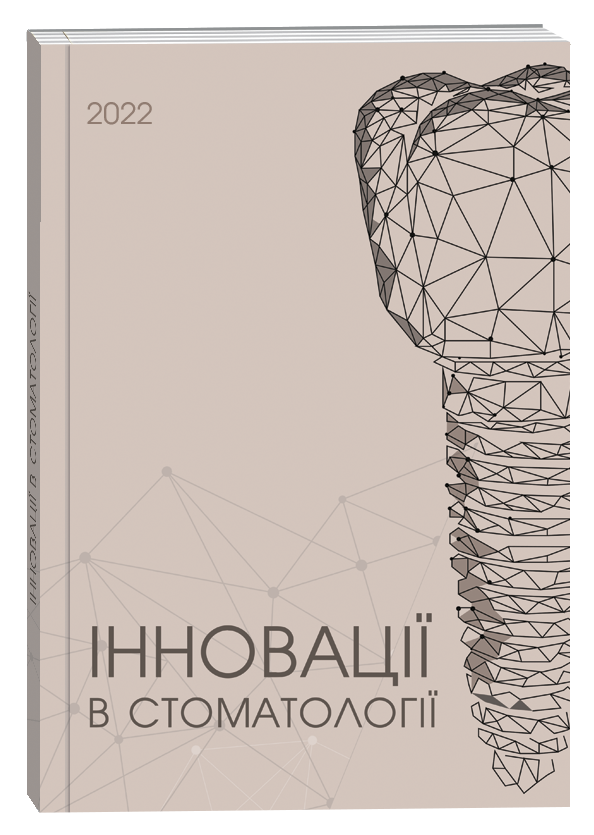ETIOLOGICAL FACTORS, CLINICAL AND IMMUNOLOGICAL CHARACTERISTICS OF DESQUAMATIVE GINGIVITIS
DOI:
https://doi.org/10.35220/2523-420X/2022.2.8Keywords:
desquamative gingivitis, dermatoses, gipoestrogenemiya, an autoimmune syndromeAbstract
Desquamative gingivitis is characterized by increased desquamation of the epithelium. It is a clinical term to describe red, painful, glazed and friable gingivae which may be a manifestation of some dermatoses with an autoimmune component. Purpose of the study. To define etiological factors and diagnostic attributes of desquamative gingivitis. Methods. 42 patients (7 men, 35 women) at the age of 19-68 years with desquamative gingivitis were examined. Clinical, radiological and immunological study were conducted. Results. It is established that desquamative gingivitis in 5 patients of young age was an independent periodontal disease, and in 37 patients (88,1%) occured – as a symptom of a generalized periodontitis. Desquamative gingivitis is diagnosed for 19 women in the post-menopausal period (45,2%), for 11 patients (26,2%) with dermatosis with an autoimmune component (oral lichen planus – 6, mucous membrane pemphigoid – 2, pemphigus vulgaris – 1, scleroderma – 1, lupus erythematosus – 1), for 6 patients (14,3%) with diabetes mellitus, for 3 patients (7,1%) with hypothyroidism, for 7 patients (16,7%) as allergic reaction (the contact gingivostomatitis). Increase of the immunoregulatory index CD4/CD8 (2,87±0,24) and a high content of low molecular weight circulating immune complexes in the blood of women with desquamative gingivitis in the post-menopausal period indicates possible development of an autoimmune syndrome. Conclusions. The main etiological factors of desquamative gingivitis are endocrine disturbances (gipoestrogenemiya, hypothyroidism, diabetes) and dermatosis with an autoimmune component. Confirmation of the desquamative gingivitis diagnosis in the presence of strong clinical symptoms requires immunological study and histopathological examination of tissue biopsies.
References
Maderal A.D., Salisbury III P.L., Jorizzo J.L. Desquamative gingivitis: Clinical findings and diseases. J Am Acad Derm. 2018. Vol. 78, N. 5. P. 839-848.
Gagari E., Damoulis P.D. Desquamative gingivitis as a manifestation of chronic mucocutaneous disease. JDDG: J Deut Derm Ges. 2011. Vol. 9, N. 3. P. 184-187.
Caton J.G., Armitage G., Berglundh T. et al. A new classification scheme for periodontal and peri-implant diseases and conditions –Introduction and key changes from the 1999 classification. J Periodontol. 2018. Vol. 89. P. S1-S8.
Holmstrup P., Plemons J., Meyle J. Non-plaque – induced gingival diseases. J Clin Periodont. 2018. Vol. 45. P. S28-S43.
Nisengard R.J., Neiders M. Desquamative lesions of the gingival. J Periodontol. 1981. Vol. 52. P. 500-510.
Lo Russo L., Gallo C., Pellegrino G. et al. Periodontal clinical and microbiological data in desquamative gingivitis patients. Clin Oral Invest. 2014. Vol. 18. P. 917-925.
Gemmell E., Yamazaki K., Seymour G.J. The role of T cells in periodontal disease: homeostasis and autoimmunity. Periodontol. 2000. 2007. Vol. 43. P. 14-40.
Koutouzis T., Haber D., Shaddox L. et al. Autoreactivity of serum immunoglobulin to periodontal tissue components: A pilot study. J. Periodontol. 2009. Vol. 80, N. 4. P. 625-633.
Maderal A.D., Salisbury III P.L., Jorizzo J.L. Desquamative gingivitis: Diagnosis and treatment. J Am Acad Derm. 2018. Vol. 78, N. 5. P. 851-861.
Cabras M., Gambino A., Broccoletti R., Arduino P.G. Desquamative gingivitis: a systematic review of possible treatments. J Biol Regul & Homeost Agents. 2019. Vol. 33, N. 2. P. 637-642.







